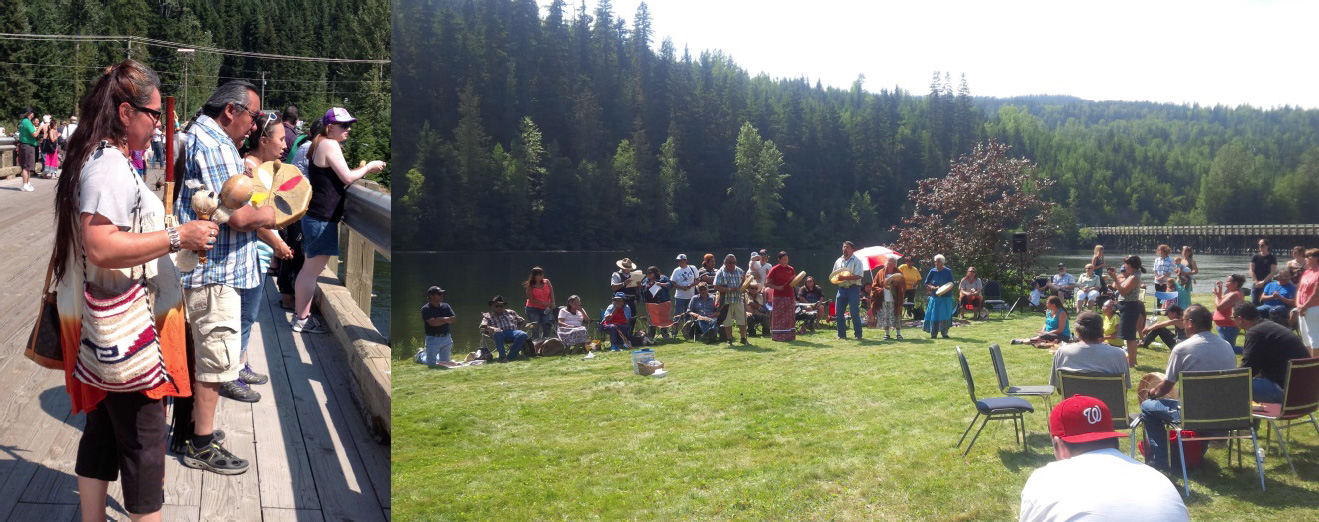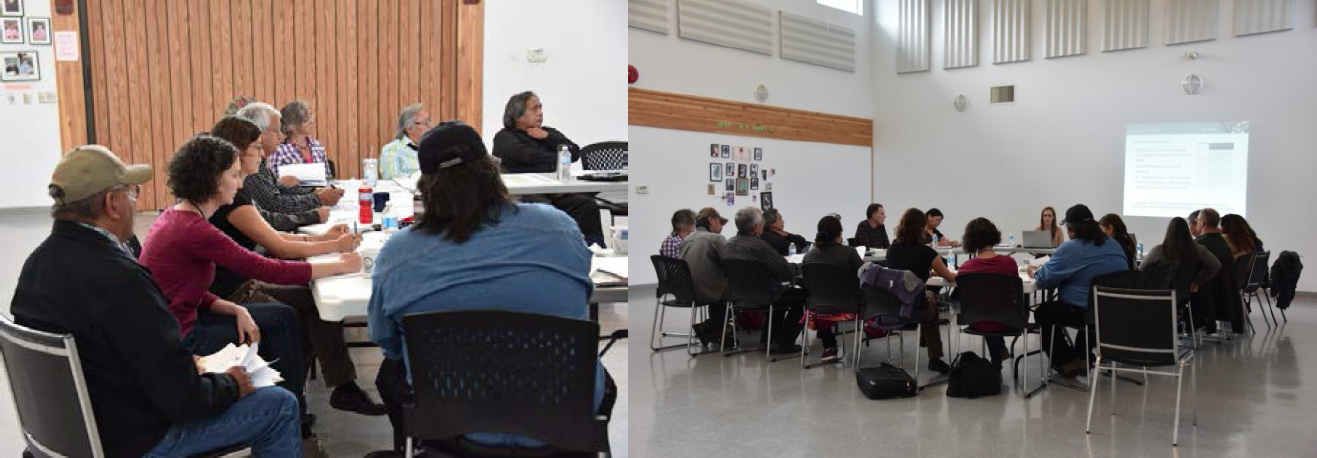Since early August, the FNHA has been working closely with impacted Nations providing independent fish and water analysis, risk assessment and crisis response services. We have reviewed the final fish sampling data and provide below the final interpretation of these results. Additionally, our team members have recently participated in a number of Nation-based forums where FNHA and Nation-based concerns to the Mount Polley breach were widely discussed. Some of the questions raised at the forums are addressed below.
 Images from Mount Polley Healing Ceremony: courtesy Joe Gallagher.
Images from Mount Polley Healing Ceremony: courtesy Joe Gallagher.
Fish Sampling Project
The FNHA would like to thank the community harvesters who have contributed fish samples to support this project. Specifically, harvesters from: Northern Shuswap Tribal Council, Esketemc, Tl'esqox-t'in, (Toosey), St'át'imc Eco-Resources, Xaxli'p, Xwisten, T'it'q'et, Nazko, Lhtako Dene, Nlaka'pamux Nation Tribal Council, ?Esdilagh and Coldwater Band (Nicola Tribal Council).
Fish testing was conducted at the request of impacted First Nations and intended to provide independent and objective information regarding the safety to consume the 2014 Fraser River Sockeye. In total, 45 fish samples were collected, representing 35 post-breach samples and 10 pre-breach samples. One post-breach sample was excluded as it was spoiled. Samples were analysed for total metals, which includes those metals that are reported by Imperial Mines to have been discharged into the tailings pond. Results were then reviewed from a human health risk perspective by two internationally recognized toxicologists.
The potential for metals to impact human health is dependent on exposure: the level of metals in the salmon and the quantity of salmon consumed. Safe consumption rates available from Health Canada and the World Health Organization were used. These rates refer to the lowest level at which there would be no appreciable risk of an adverse effect to the body, and are considered to apply to all individuals – young or old, healthy or not. In the case of lead and manganese, children are more susceptible therefore the value for children is lower and more protective.
Because First Nations people consume significantly more salmon than the general public, our risk assessment was specific to the amount of salmon consumed by BC First Nations. We assumed a lifetime consumption of one bowl per day for adults and one-half bowl per day for toddlers. These values were based on data obtained from the First Nations Food Nutrition and Environment Study (FNFNES, 2009).
Comparison to available baseline data is another method to evaluate if results are within normal ranges found pre-breach. The FNHA received contributions of salmon caught in 2013 and would be considered control samples, since they would not have been impacted by the 2014 tailings breach. Additionally, the First Nations Food Nutrition and Environment Study (FNFNES) conducted in 2008-09 in BC provides data for metals in salmon. More information on the study can be found at: http://www.fnfnes.ca/.
Summary of results:
• From a metals perspective, most metals are in normal ranges compared to pre-breach, and in all cases metals are below levels of human health risk.
• Selenium concentrations are in the normal range and are below the risk-based screening concentrations.
• Levels of inorganic arsenic are very low and do not present a human health risk. The inorganic form of arsenic is the harmful form. Levels are also consistent with other available studies.
• Salmon liver and roe levels do not present a human health risk from a metals perspective. This assessment took into consideration that liver and roe are consumed with muscle tissue.
• Our results did show that nickel is higher than found in our baseline data but is still within safe levels. The post-breach sockeye nickel levels are however, quite similar to the FNFNES dataset for the other types of salmon.
• Long term monitoring of fish will be needed to determine if fish habitat has been impacted or if future salmon runs will have accumulated the metals of concern.
The fish submitted to the FNHA fish sampling project and current data represent fish that would likely have been in the Fraser River at the time of the tailings breach, and what people would likely consume. Ill-looking fish were not submitted. It is generally advisable that fish which appear to be ill or which are dead should not be consumed. All fish used in the FNHA fish sampling project were collected by First Nations harvesters with the support of FNHA EHO's and First Nations resource/fisheries technicians.
The FNHA did receive copies of results for water and sediment samples collected by Imperial Metals and Ministry of Environment (MOE) but only to provide independent interpretation for the information and decision-making of impacted First Nations. FNHA did not receive any fish samples by either group for this project.
A number of questions have been raised regarding the general health of fish and the possible reasons for ill-looking fish. FNHA does not have the expertise in fish health and have requested information from the Department of Fisheries and Oceans.
Next Steps
In partnership with impacted Nations there is an analysis underway of the federal, provincial, and industry roles and responsibilities in terms of the longer-term monitoring and remediation. In doing this analysis, we will better understand where gaps may exist and will inform long-term testing, monitoring, and support of impacted First Nations communities.
FNHA will continue to work directly with impacted First Nations, and in order to better support communities, would like to gather additional information which may be relevant to this event. Additional and historical information that has been gathered by First Nations and others will provide a clearer picture and will support FNHA to work alongside communities in interpreting risks to health.
Additionally, the upcoming Regional Caucus sessions also provide an opportunity to collectively review the roles of the FNHA / FNHC in relation to crisis response, to reflect on how we engage with each other and our partners, and ensure that the holistic view of health is maintained and protected through crisis situations.

IMAGES courtesy Levi BlackWolf: Community meeting FNHA and St'at'imc Fisheries Technicians September 24, 2014 at Xaxli'p.
Q/A
Previously it was indicated that most metals were similar to pre-breach levels. Were there any metals that were higher than pre-breach levels?
The primary objective of testing program was to determine if fish were safe to consume by First Nations communities (due to the small number of pre-breach samples, we did not specifically design the program to determine if post-breach fish have greater concentrations of metals in their tissues). Nevertheless, it does seem that our post-breach dataset for sockeye has nickel concentrations that are higher than both the pre-breach dataset and the FNFNES dataset for sockeye. However, the post-breach sockeye nickel levels are quite similar to the FNFNES dataset for the other types of salmon. In the literature there appears to be variability of nickel concentrations for salmon and so it is not clear the reason for the increase in this specific situation. For all metals including nickel, the typical concentrations in post-breach sockeye are much lower than the safe level.
Did FNHA accept samples that were collected by Imperial Metals?
No, FNHA did not accept samples which were collected by Imperial Metals. FNHA has only received copies of results pertaining to samples collected by the company. The results for tailings supernatant, sediment, and water quality (Quesnel Lake, Polley Lake and Quesnel River) helped to inform us on what contaminants were present historically. For samples taken by MOE and Imperial Metals after the breach, FNHA provided an independent interpretation of the results. For the FNHA fish sampling project, all fish submitted were collected by First Nation harvesters, and packaged/shipped by either FNHA EHOs or FN resource/fisheries technicians. Fraser River water samples were collected by FNHA EHOs.
Why did MOE/Imperial Metals not use First Nations technicians?
It is our understanding that both MOE and Imperial Metals engaged with the Soda Creek and Williams Lake Indian Bands at an early stage so that they may be involved in the field work.
What species of fish were collected?
At the time of the fish sampling project, FNHA desired to collect a variety of salmon species. Of the fish contributed by harvesters, all but one was sockeye. This may have been due to the timing of the sockeye salmon run and the preferred harvest at the time. Future monitoring would benefit from having a variety of species analysed.
Why were some fish appearing to fall apart?
FNHA does not have scientific expertise in fish health. We have requested information from Department of Fisheries and Oceans which may explain this appearance.
Was the ill-looking fish tested?
Although FNHA did not receive samples of the fish that appeared ill, we are aware that Xaxli'p First Nation has independently submitted an ill-looking fish for analysis. The FNHA risk assessor is willing to interpret those results. It is generally advisable that fish which appear to be ill or which are dead should not be consumed. Therefore the fish submitted to the FNHA fish sampling project and current data would represent what people would consume.
Is FNHA willing to collaborate with communities who have carried out their own independent testing?
Yes, there is significant value in collaborating on any current and future work carried out in response to the Mt Polley tailings breach. As this incident has resulted in far-reaching concerns, it is ideal for FNHA to be aware of the information that has been obtained by communities and to be able to support communities in interpreting risks to health. Furthermore, having a larger data set will help us collectively understand the extent of impacts. The Mt Polley Mine Breach Environmental Working Group is also interested in looking at all available data collectively to in order to have a greater dataset from which to assess the impacts and determine the needs for future work.
Updated links:
MOE Mount Polley Incident site: http://www.env.gov.bc.ca/eemp/incidents/2014/mount-polley/
MOE Updated Chronology of Events http://www.env.gov.bc.ca/eemp/incidents/2014/mount-polley/pdf/20140924/MtPolley_ChronoEvent_24Sept2014.pdf
MOE Frequently Asked Questions (updated) http://www.env.gov.bc.ca/eemp/incidents/2014/mount-polley/pdf/20140924/FAQ_MtPolleyOpenHouse_25Sept2014%20(3).pdf
MOE Factsheet – Sampling and Test Results http://www.env.gov.bc.ca/eemp/incidents/2014/mount- polley/pdf/20140924/FS_MtPolleySampling_24Sept2014.pdf
Download a copy of this communique in PDF form here. (521 KB)

